Helicopter rescue in the Himalayas, interview with Moro, Folini and Senoner
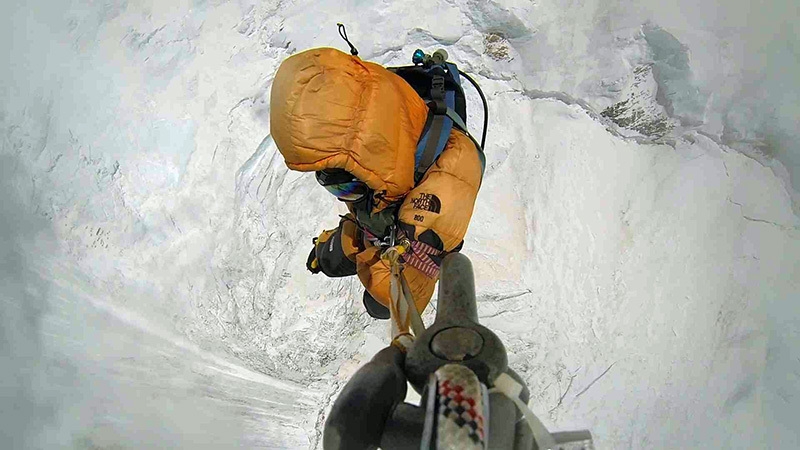
 1 / 9
1 / 9 archivio S. Moro
archivio S. Moro
The helicopter was flown by ace pilot and Mountain Guide Maurizio Folini, while the crew was comprised of myself and Armin Senoner. Let's just say that the rescue was carried out at around 23,000 feet (about 7,000m Editor's Note), which corresponds to the maximum altitude my helicopter can and is certified to fly... You know, the helicopter world isn't the same as that of mountaineering, you have to be careful with what you say because instead of being applauded for having saved someone's life, your might end up with some disciplinary action, if not worse. On the rescue day we didn't check our altimeter precisely because we were focused on doing the right manoeuvres... Armin and I disembarked at Camp 2 at 6500 metres and we only assisted via radio and helped communications with the Sherpa who were helping the injured climber higher up, while Maurizio tried to rescue him using the long line. In April, before Maurizio's flight, operations were carried out by another very good pilot specialised in high altitude missions, namely Enrico Cereia from Biella. And for a couple of weeks in May Piergiorgio Rosati flew another helicopter, an As350 b3 belonging to Fishtailair.
Can you explain what you did and why this was a "record" rescue?
Maurizio Folini: Until then, the highest ever rescue had been carried out at 6,900 feet, ours was higher...
Simone Moro: A Nepalese naturalised Canadian double amputee decided to attempt Everest despite his disability. He had managed to reach the summit with the help of his support Sherpa but on the way down he became exhausted and was unable to descend any further. Hence the call, seemingly impossible, for rescue from "around 23,000 feet" (it's ridiculous that one doesn't know the exact altitude...). We immediately got underway and, in order to be fast and efficient, we took off from Lukla. First we landed at Base Camp on the South side, then we made the helicopter lighter by removing its doors and seats and then flew to Camp 2 on Everest at 6,500 metres. Both Armin and I jumped out and got radio contact with the Sherpa who were assisting the climber; they guaranteed that they were ready to clip him to Maurizio's long line (a 20m rope below the helicopter with a carabiner at the end). Usually there is a rescue member attached to the long line but seeing the altitude and the resulting reduced operating ability and thrust we had decided to go extremely light and delegate operations via radio to the Sherpa. Everything ran smoothly: the Sherpa were fast and efficient, but Maurizio was quite simply unbelievable. After he rescued the climber - surprising everyone and everything - we felt moved, Maurizio himself included. Were we from another country the entire world would be talking about us and perhaps we'd be more careful about the altitude... and about communications... but it's fine like this. The aim wasn't to set a record but to save someone's life.
Maurizio Folini: tell us about the difficulties of flying at that altitude... both technical and human. Presumably you can't suddenly improvise a flight like this?
You don't suddenly improvise a flight of this sort, just like all flights aren't improvised. You have to be prepared, technically, physically and also mentally. During the mission you feel in control thanks to the helicopter itself which you need to know in minute detail, and thanks also to years of experience that enable you to deal with all technical and natural parameters (wind, altitude, clouds, etc.). But the most important thing of all is feeling at ease with oneself, trusting in your own abilities, being able to rely on a close-knit team. Hearing the voice via radio of my friend and mountain guide Armin Senoner, who together with Simone Moro watched things unfold from the upper camps, gave me the confidence and peace of mind which enabled me to concentrate on what I was doing.
Armin Senoner, the same question to you about the technical difficulties and... the human ones. And furthermore, do you ever get used to dangling off the line and how much do you have to trust the pilot?
Well, you need to trust the pilot completely. Luckily Maurizio and I hit it off really well right from the outset and we both completely trust each other. What is difficult is that in such a short instant you suddenly find yourself at a really high altitude. We set off from 2800m and immediately flew to 6200m, so there's really little time to get acclimatised. It's difficult to get used to the longline because the panorama itself is breathtaking and the polar temperatures certainly don't help... but you try to remain calm and reassure the pilot that everything's okay and that you're having fun, so that he doesn't get worried and lose focus. In the end though, when everything is done perhaps you've even managed to save someone's life and so you're rewarded for all your efforts and fears.
I'm certain that had the Taiwanese alpinist survived (on another rescue mission), you would have been much happier... The question that springs to mind is always the same one: with all that traffic of people up on Everest during those days, how's it possible that no one, apart from the Sherpa, helped him?
Simone Moro: we got really close to saving the mountaineer from Taiwan, just a few metres from clipping him in, but unfortunately the helicopter was simply too close to its limit. A bag of groceries clipped to the longline would have brought it down. It was unthinkable therefore to clip in someone as big as the Taiwanese... Having said that, we were saddened by the fact that the alarm was raised so late after, for 2 days, he had been left to sleep out in the open above 8000m without anyone doing very much in particular. We were all set to try again but just a few hours before the flight the climber died...
Maurizio Folini: We made three attempts (even though we knew we stood only a tiny chance). On numerous occasions we asked the other alpinists and Sherpa to help us, to get the stranded mountaineers down at least a further 300/400 metres. This is usually feasible in 3/4 hours, but no one listened to us. The only one willing to give us a hand was Damian...
We know that you also carried out numerous other rescue flights...
Simone Moro: Practically every day... from trekkers and their simple illnesses to high altitude missions and those in remote areas. However we never used the word rescue and we always defined it as SAR (search and rescue) which pretty much means the same... but it adheres to the terminology we are allowed to use by the aviation authority. Don't forget that the word "rescue" can trigger anger and envy from which I want to steer clear. In short, I'd like to avoid having to register my helicopter in another country simply to avoid linguistical and regulatory issues. I sincerely hope that the I-VIEW helicopter will become the pride of a nation (Italy) and a national operating system (not just ours), instead of being subject to the usual gossip and obstructionism. Let's just say that if mountaineering is shrouded in controversy, then I've discovered more subtle and poisonous forms in the rotorcraft world. So, it's down to business as usual :-)
Can you tell us about your most significant missions?
Maurizio Folini: the most challenging and meaningful for me was the three-day rescue on Dhaulagiri. In addition to rescuing 12 people (three of which at over 7,000 metres), I had to coordinate the entire organisation which had slipped out of control from the Nepalese authorities and agencies. For the first time ever we flew rescuers to circa 7000m via long line and from there they climbed to 7800 metres to continue the rescue operations. This was certainly a step forward in terms of organising Himalayan rescues.
Simone Moro: the missions on Everest, Kangchenjunga, Dhaulagiri and other smaller mountains were the most challenging, complicated and also distant. You always need to solve the problem about fuel supplies and the ensuing autonomy of flight operations, and even here you need to use all the tricks in the books... But everything was carried out without causing any accidents, always complying to the rules in a difficult environment as is Nepal. We always worked things out carefully in advance and the results prove this.
Another silly question maybe, but why do you do it? And above all... tell us about your project?
Maurizio Folini: We love our jobs and the mountains. Our aim is to have a professional team for Himalayan rescue operations.
Simone Moro: We definitely aren't doing this for money or glory. We all have what we want and deserve from our professional spheres. The idea of creating a rescue unit which owns its own helicopter is something I've had in mind for a while and which I began to work on in 2009 with my commercial pilot's license. A very good Swiss unit was already operating in Nepal at the time, providing training and carrying out rescues with the use of helicopters already based in Nepal. But I wanted a helicopter dedicated exclusively to rescue operations, at least during the high mountaineering season and with the best pilots and alpinists in the world. Well, at risk of being immodest, I think the results we've obtained aren't exactly bottom of the class. We carry out rescue missions because the time has come that someone starts to offer a safety service which is proportional to the number of tourists and climbers who come here and which responds to the mountainous nature of the country and its people. In fact, we also do plenty of flights for the local population, very often for free or at extremely reduced prices. Last but not least, my whole project doesn't cost the Italian or Nepalese taxpayer a single cent. It's all financed privately and I also paid, and am still paying, for the helicopter out of my own pocket...
Let's just say that we're a close-knit team of pilots, technicians and "mechanics". I have to admit that Bruno Bortolameotti, the man who gets his hands dirty maintaining the helicopter in loco, is our icing on the cake. While here, in Italy, Elicampiglio and Attilio Gianoli are the two who supervise operations and maintenance.
How much of all this is "voluntary", and how much "business"?
Maurizio Folini: It is a mix of voluntary and business. There are flights for which we don't get paid, and others for which we get paid well.
Simone Moro: For two years I, Folini and Pigi flew for free with Nepalese helicopters. At the end of the 2011 and 2012 seasons Folini and Pigi (Piergiorgio Rosati, Editor,s note) received a "tip" from Fishtailair, a sort of small gratification, nothing compared to their European salaries. Until now I, quite rightly, haven't received even that. Now that I have to pay for a helicopter I have rented it out to Fishtailair. For every flight they pay me a sum which goes towards maintenance costs as well as the cost of purchasing the helicopter. But it's a delicate, difficult balance to strike. And just to cast away any doubts: it's worth knowing that I get paid the same for an hour's extreme emergency flight as the same hour for a tourist flight, even if the difficulties and risks are astoundingly different. Furthermore, if I carry out operations even "slightly" above 23,000 feet then this can create an entire series of potential problems which are best not listed and better left to those who know a thing or two about this world...
So who pays, and how much, for your assistance in the Himalayas?
Simone Moro: the flights are paid by those who are rescued or by their insurance companies. There have been controversies and exploitation of possible "games" concerning prices which have risen when insurance companies are involved or when there were particular urgencies. I honestly don't know anything about this and cannot prove anything since, as I said, I get paid the same regardless of the severity and urgency of a particular mission. All I'd like to say is that flying in Nepal at 3000 and at 7000 metres isn't the same thing, the difficulties and associated risks vary and it is right therefore that the costs are not identical, seeing that no one wants to carry out the higher and more extreme operations and the economic and insurance risks are borne exclusively by the owners of the helicopter and those who operate it. I'd like to add that there is no lack of work at low altitudes in Nepal and that therefore there's no interest in fermenting and inventing rescue missions.
Some argue that these rescue operations on Everest might make those who venture onto the climb without the necessary preparation even less accountable. What do you think?
Maurizio Folini: Maybe it's true... but it's inevitable nevertheless. Commercial expeditions and the entire "circus" that revolves around the Everest business is interested in "numbers" and we cannot control this. I don't think that more or less people will come to Everest if there is or isn't a helicopter rescue service. Those who want to go there will do so regardless. We've got the same problem in the Alps and it's inevitable that it'll happen in the Himalayas.
Simone Moro: It's like saying that having more ambulances will induce people to drive more dangerously or to get hurt more often. I respect this point of view, but it's fallen ill with idealism. We all want to be rescued in the Alps, on the normal routes up Mont Blanc, along the paths on hillsides, at sea, in caves, on roads, but when it comes to Nepal and Everest then this is no longer accepted. Apart from being racist, this approach is also blind to a tourist reality which involves an enormous amount of foreigners who without the helicopter rescue service might die (as sometimes happens) in a bed in one of the many lodges scattered across the high altitude villages. The destinations for plenty of simple and completely respectable trekkers. The Everest rescue missions, those above Base Camp, are simply 1% of the total operations. They are surrounded by plenty of hype, but there are very few of them.
From the "rescuers" point of view, how do you judge the present situation on Everest? From here it seems as if things are deteriorating more and more and that maybe something should be done regarding "mountaineering culture" and "safety"...
Simone Moro: all you need to do is adhere to a simple rule that would help common sense which, all too often, has been lacking up on Everest, namely that you need to have climbed at least two 8000ers prior to attempting Everest. Like this the tourist revenue would remain the same, but it would be spread out across more mountains and valleys, benefitting other places and not just the Khumbu valley. And those who then attempt Everest would be slightly better equipped to deal with it. I've suggested this for quite some time and it would only serve as a first, very rudimentary technical filter to the highest mountain in the world.
Maurizio Folini: unfortunately the ability level of Everest "candidates" has fallen dramatically, on the other hand this is happening in the Alps, too. Up until a few years having climbed Mont Blanc meant something, now you're just one of many, exactly like on Everest.
It seems as if your team has become a reference point in the Khumbu Valley, and further afield ... is this true?
Maurizio Folini: yes, it's true, one can notice the technical and cultural difference and that's why people appreciate us.
Simone Moro: yes, for sure. This year it was really satisfying to see just one helicopter do these missions. Fishtailair that hired us deserves these results and the trust they placed in us was reciprocal and they have certainly been rewarded for this. The alpinists, even those who criticised me, and the Sherpa, even those who attacked me (go to the interview of 04/29/13 ed), ended up calling us to take them home or get them out of trouble. We always did this, without ever looking for too long in the eyes of those who maybe should have lowered them... Helping someone isn't a question of sympathy but a personal attitude, a sense of civic duty, devoid of personal gain and preferences.
Simone, how do you see future rescue operations in the Himalayas ...
I hope it will soon be structured in a more solid manner and maybe not only with a single unit as is presently the case. We cannot answer calls from help from Kangchenjunga, Everest and Annapurna on the same day on our own. It's certainly not a matter of having more helicopters, but more pilots like Folini and those who know the area like the back of their hands. One need a team of alpinists, better still Sherpa, ready to be dropped off on the mountain and to ascend with their own means where the helicopter cannot fly, or when weather conditions are prohibitive (wind or poor visibility). And then one needs a team of medics, who more often then not need to be willing to being lifted up to a certain altitude or even left alone close to the mountain due to the helicopter's operating limits. In short, an entire system designed specifically for high altitudse and not simply an exact copy of the Italian system, efficient but all too often expensive and colossal. In short, no twin-engines and stationary units, but "free-range" crew, small and lightweight (single turbine) helicopters, smooth and light operations. In practice, a rescue service which until a few decades ago was in place here at home and which is still in place in some countries, first and foremost in Switzerland. Perhaps this answer will anger many, but in Nepal either you work well, or you remain grounded, drowning in debt and with heavy, useless helicopters.
What has, for better or for worse, this experience given you?
Maurizio Folini: It's a pretty important life experience. The technical and cultural approach to organising a rescue in the Himalayas is a huge challenge. All the people I have come to know during this period, from different countries, somehow enrich a huge and wonderful wealth of experience.
Simone Moro: The awareness that much can be done even without public finance. That being Mountain Guides and Pilots operating in the Alps is a great advantage when adapting to the needs of a country which is similar but which has twice the altitude as that at home, and very few roads. That the helicopter I bought is an incredible cost for me personally but an extreme advantage for many and for a country I love. And it was with great pleasure that I supported the film project of Reinhold Messner and his team. Messner was ecstatic and fully supports my, our, project. It's important support, even only from a moral point of view.
Last question Simone: When will you return into your "alpinist" vest?
Well, at the end of this year. Nanga Parbat in winter is on the agenda, just like two winters ago, it'll be my goal and my dream to be carried out in the coldest season of the year.
>> 16.05.2012 Simone Moro between Everest, Lhotse and helicopter rescues
>> 01/06/2011 Simone Moro and helicopter rescues in Nepal



 Copia link
Copia link

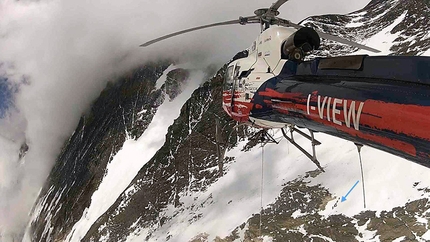
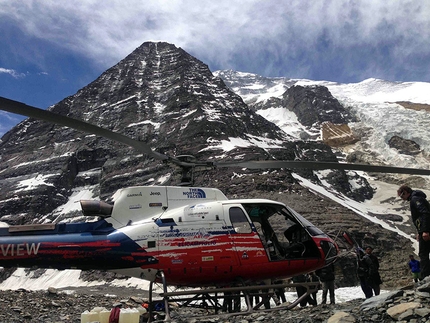
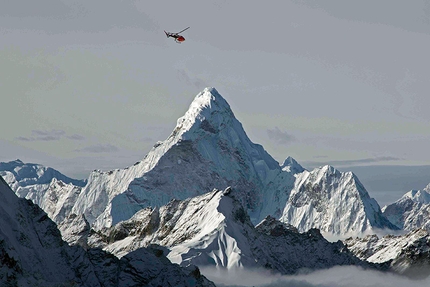
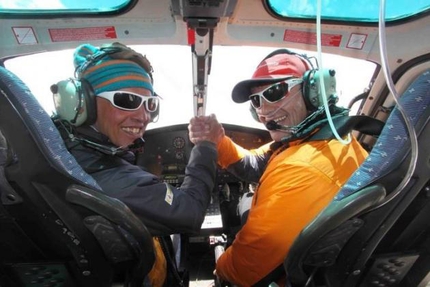
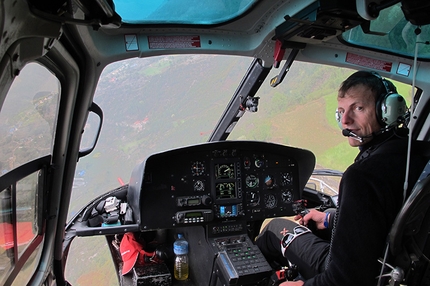
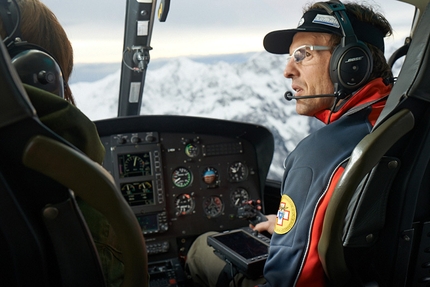
 See all photos
See all photos





















